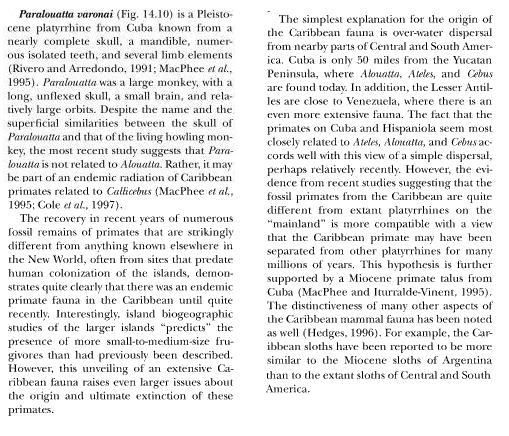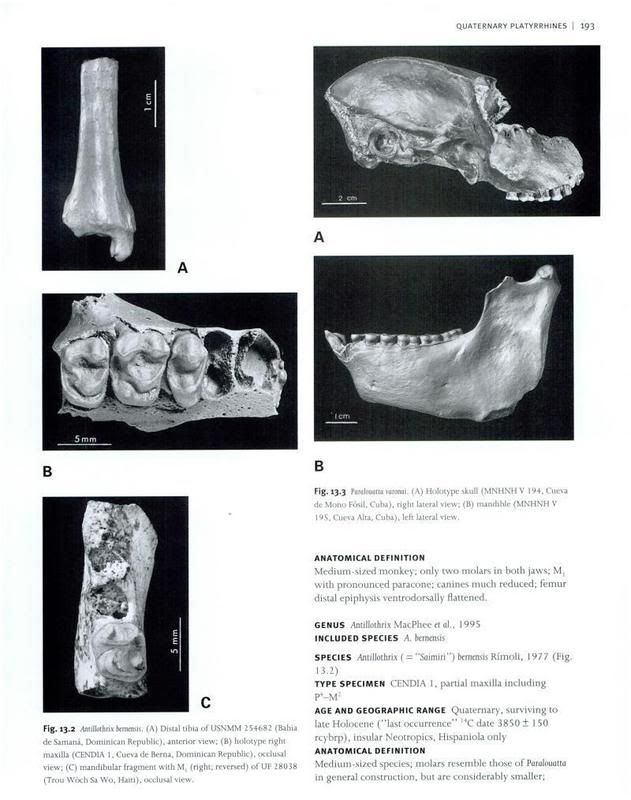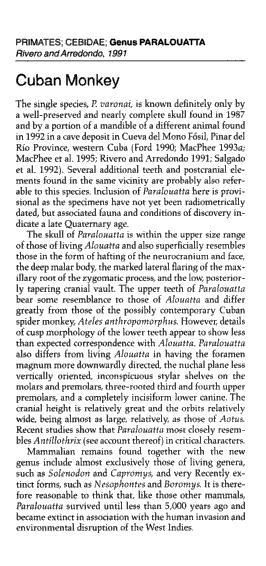|
|
Post by Melanie on Nov 16, 2007 20:27:10 GMT
The Cuban Monkey (†Paralouatta varonai) is an extinct species of small primate that lived on the island of Cuba. The Cuban fossil primate, Paralouatta varonai was described from a nearly complete cranium in 1991. This cranium and a number of isolated teeth and postcranial bones were found in a cave site in Pinar del Rio Province. The initial description of the cranium included a proposal that Paralouatta varonai was a close Caribbean relative of the extant Alouatta (howler monkeys) of Central and South America,[1] but this taxonomic placement has been called into question with the analysis of the dental remains.[2] Based on shared similarities with the two other Caribbean primates Xenothrix mcgregori and Antillothrix bernensis. MacPhee and Horovitz have proposed that the Caribbean primates are part of a monophyletic radiation which entered the Caribbean at the Oligocene-Miocene boundary. More recent research confirms this assessment and places these three species in the tribe Xenotrichini.[3] en.wikipedia.org/wiki/Cuban_MonkeyParalouatta varonai could have survived until 3000 BC (German Wikipedia) |
|
|
|
Post by Melanie on Nov 16, 2007 20:57:08 GMT
www.amnh.org/science/biodiversity/extinction/ResourcesBestiaryBgeo.html Sub-class Placentalia Order Primates Family Pithecidae (titis and related New World monkeys) Species Paralouatta varonai  Endemic monkeys lived on several of the Greater Antilles during the Quaternary. Paralouatta varonai, which lived in Cuba, was a relatively large species that may have weighed as much as a living howler monkey (Alouatta, 15-20 lb). All extant platyrrhines are exclusively arboreal, but some limb bones of Paralouatta are remarkably similar to those of monkeys that spend part of the time on the ground (e.g., langur monkeys, genus Presbytis). Bones of Paralouatta have only been found in cave sites in one area of western Cuba, the Sierra de los Organos. It has not yet been established when this species became extinct; it may have died out comparatively early. None of the material recovered from the cave sites is associated with evidence of humans. See also: MacPhee, R.D.E., 1996. The Greater Antillean monkeys. Revista de Ciència 18: 13-32. ------------------------------------------------------------------------ Somebody had more information about this extinct primate? |
|
|
|
Post by another specialist on Nov 17, 2007 19:51:39 GMT
We describe recently recovered dental and mandibular remains of the Cuban platyrrhine Paralouatta varonai, previously known from the holotype only (a nearly complete skull with very worn teeth). We also expand on the original description of the type specimen. Paralouatta is one of three extinct taxa of Greater Antillean Quaternary monkeys known from craniodental remains. The other two, Xenothrix mcgregori and Antillothrix bernensis, occurred in Jamaica and Hispaniola, respectively. It has been common practice to assume that Antillean monkeys were more closely related to individual mainland taxa than to each other. Thus, P. varonai was thought to be related to Alouatta; Antillothrix bernensis to Saimiri or Cebus; and X. mcgregori to Callicebus, or to callitrichines, or even to be of unknown affinity. With the discovery of well-preserved dental remains of Paralouatta, it can now be ascertained that this species was in fact very different from Alouatta. Cladistic analysis reveals a sister-group relationship between Antillothrix and Paralouatta, followed on the cladogram by Xenothrix and Callicebus (last taxon being the closest mainlaind relative of the Antillean clade). This conclusion has an important biogeographic implication: recognition of an Antillean clade, as advocated here, assumes only one primate colonization from the South American mainland, not several as previously believed. Copyright 1999 Academic Press www.ingentaconnect.com/content/ap/hu/1999/00000036/00000001/art00259 |
|
|
|
Post by another specialist on Jul 12, 2008 5:58:24 GMT
|
|
|
|
Post by another specialist on Jul 12, 2008 6:18:26 GMT
|
|
|
|
Post by another specialist on Jul 12, 2008 6:19:05 GMT
|
|
|
|
Post by another specialist on Jul 12, 2008 6:19:43 GMT
|
|
|
|
Post by another specialist on Jul 12, 2008 6:20:16 GMT
|
|
|
|
Post by another specialist on Jul 31, 2008 12:19:39 GMT
  Primate Adaptation and Evolution By John G. Fleagle |
|
|
|
Post by another specialist on Jul 31, 2008 12:23:11 GMT
 The Primate Fossil Record By Walter Carl Hartwig |
|
|
|
Post by another specialist on Jul 31, 2008 12:48:26 GMT
 Walker's Primates of the World By Ronald M. Nowak, Ernest Pillsbury Walker, Russell A. Mittermeier, William R. Konstant, Anthony B. Rylands |
|
|
|
Post by surroundx on May 6, 2015 14:13:03 GMT
|
|
|
|
Post by Sebbe on Oct 24, 2015 11:15:58 GMT
|
|
|
|
Post by surroundx on Jan 24, 2016 13:23:16 GMT
|
|
|
|
Post by Sebbe on Nov 8, 2024 11:35:05 GMT
|
|
|
|
Post by Sebbe on Nov 8, 2024 14:45:34 GMT
|
|